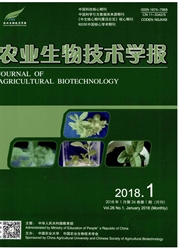

 中文摘要:
中文摘要:
光系统Ⅱ亚基蛋白R(photosystem Ⅱsubunit R,PsbR)是光系统Ⅱ的一个小分子亚基蛋白,其在植物光合生理活动过程中发挥重要作用。为探究PsbR基因在白菜型冬油菜Brassica campestris)抗寒过程中的功能,本研究以强抗寒白菜型冬油菜陇油7号为材料,运用mRNA差异显示技术DDRT-PCR(differential display reverse transcription PCR)和eDNA末端快速扩增技术(rapid—amplification of cDNA ends,RACE)方法从叶片中克隆到风勰基因(GenBank登录号为KC894423)全长。序列分析结果显示,该基因全长为570bp,编码包含417bp的一个完整开放阅读框(open reading frame,ORF),其编码138个氨基酸,蛋白分子量约为14.39kD,等电点为9.42,该蛋白属于PsbR超家族,与甘蓝(B.oleracea var.oleracea)、山嵛菜(Eutrema salsugineum)和芥菜型油菜(B.juncea)的PsbR蛋白相似性关系较近。采用qRT-PCR研究低温胁迫下白菜型冬油菜PsbR基因的相对表达量以及应用CIRAS-2便携式光合作用测定系统和FMS-2便携脉冲调制式荧光仪研究自然降温过程中冬油菜功能叶的净光合速率fh)和光合系统Ⅱ(photosystemⅡ,PSⅡ)原初光能转化效率(Fv/Fm)。研究结果表明,随着胁迫温度(4℃,-4℃和-8℃)降低,PsbR相对表达量下降,而Pn和Fv/Fm也随自然温度降低而下降,说明低温可能会抑制PsbR基因的表达,进而导致白菜型冬油菜光合速率下降、光系统Ⅱ光能转化效率降低。研究结果为解析白菜型冬油菜PsbR基因的生物学功能和抗寒机制提供了部分理论依据。
 英文摘要:
英文摘要:
Photosystem Ⅱ subunit R (PsbR) is a small subunit protein in photosystem Ⅱ and plays important roles in photosynthetic physiology of plants. To investigate the function of PsbR in winter turnip rape (Brassica campestris), a strong cold-tolerance winter turnip rape cultivar "Longyou 7" was used as experimental materials in this study. The PsbR was separated and cloned from the leaf by differential display reverse transcription PCR(DDRT-PCR) and rapid-amplification of cDNA ends (RACE). The full length cDNA of PsbR was 570 bp and the open reading frame (ORF) encoding a protein of 138 amino acids was 417 bp. The accession number was KC894423 in GenBank. Its molecular mass was 14.39 kD and the isoelectric point (pI) was 9.42. The prediction of the second structures indicated that PsbR was a steady protein and had a transmembrane region and contained a conserved amino acid sequence. PsbR belonged to the PsbR superfamily, which presented high similarity with PsbR proteins from B. oleracea var. oleracea, E. salsugineum and B. juncea. The relative expression of PsbR gene under low temperature stress and the net photosynthetic rate (Pn)and efficiency of primary conversion of light energy of photosystem Ⅱ (Fv/Fm) in the natural temperature falling were determined with qRT-PCR technology, CIRAS-2 photosynthetic apparatus and FMS- 2 pulse modulated fluorometer, respectively. The main results showed that as temperature fell, the expression of PsbR, Pn and Fv/Fm decreased. Therefore, the expression of the PsbR gene may be inhibited under low temperature stress and then decreased net photosynthetic rate and photochemical efficiency of PS lI. The results provide a theoretical basis for resolving the biological functions of PsbR and the cold-tolerance molecular mechanism of winter turnip rape.
 同期刊论文项目
同期刊论文项目
 同项目期刊论文
同项目期刊论文
 期刊信息
期刊信息
